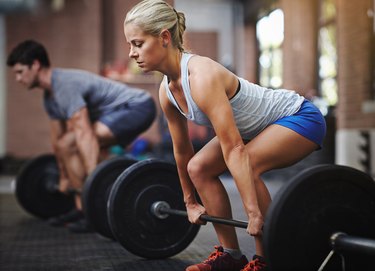
You won't be shocked to hear that shoulder shrugs work the shoulders — this time, it really is all in the name. Whether you're shrugging with dumbbells, a barbell or a pulley, you're squarely targeting the traps.
But just because shrugging is an isolated movement — meaning it employs just one joint movement — that doesn't mean its benefits are isolated to just the trapezius. Traps are definitely the shrug's specialty, but this accessible exercise taps some additional back and neck muscles along the way.
Video of the Day
Video of the Day
Tip
Shoulder shrugs primarily target the upper trapezius muscle and you are also hitting synergistic and stabilizing muscles, including the middle trapezius, levator scapulae and erector spinae.
Target: Upper Traps
In all of its myriad variations, shoulder shrugs focus on working the upper trapezius, the shoulder muscle that runs from the top of your shoulder joint to the middle of your neck. Though it's mostly a superficial muscle (and one that bodybuilders, fighters and action stars love to show off), the trapezius does support the rotation of your scapula, which enables you to raise your arms above shoulder level.
As for why this exercise works the traps, it's all in the shrug itself. The upward pulling force of the motion contracts the traps, which relax again as you lower the weight. You can get a feel for this even if you're on the couch or at your desk; just pull your shoulders upward in the highest shrug you can, and you'll feel those traps tighten right up.
Warning
Avoid injury and muscle strain by using proper form for the shoulder shrug. The shrug should be a vertical motion moving the shoulder up and down. Avoid circling the shoulder or moving it forward or backward during this exercise. Also, be sure that you are lifting an appropriate weight for your fitness level.
The Synergist Muscles
They're most definitely the target muscle, but the benefits of the shrug don't end at the traps. That's because when you move your muscles, your body employs other muscles to help you complete a full movement. Those helper muscles are called synergists, advises ExRx.net.
When you shrug, the movement engages the middle fibers of the trapezius, too, working out the high back muscles below the upper traps. Likewise, shrugs employ the levator scapulae, a muscle that you can feel if you put your hand right on the side of your neck. This is the muscle that holds your scapula in place against the trunk of your body.
The Stabilizer Muscles
Like synergists, stabilizers are sort of helper muscles for any given movement. As the name suggests, they contract during exercise to help, well, stabilize your position.
That's the job the erector spinae, the long muscles that run from your tailbone right up to your lower neck, do when you shrug. And while you might not hear lots of people brag about the hottest new erector spinae exercise, it's an important muscle to work. If your lumbar region is weak, you're looking at an increased risk of back injury.